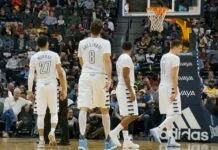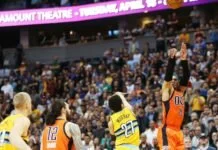While the Avalanche seek to rebuild following their abysmal 48-point season, many of us are searching for answers on how to return the once great franchise back to prominence. The keys to fixing the team are figuring out their offensive production that, at 2.01 goals per game, left the Avalanche dead last in the NHL as well as strengthening the defensive group who had a hand in allowing the most goals against in the NHL at 3.37 goals per game.
With that, the 5280 Sports Network Avalanche team looks at Tyson Barrie and his value in the Avalanche system in this month’s edition of The Shootout. Now entering his seventh year in the Avalanche Organization, is Tyson Barrie still an important part of Colorado’s growth or should the Avs explore moving him?
Tyson Barrie’s offensive talent fails to offset his deficiencies on defense.
Nathan Roth
The evidence against the 25-year-old developing into a capable player in the defensive zone is becoming insurmountable after he completed the 2016-17 season with a league-worst minus-34 rating. Admittedly, plus/minus is not a perfect statistic, but when the numbers are this significant, they certainly hold weight.
Those that are enamored with his offensive ability can overlook all of this. But his offensive numbers fell off last season after getting a new 4-year contract the previous offseason. He scored 13 less points and five less goals than he averaged in the two prior seasons.
JJ Jerez
In a year where everyone on the team struggled to produce any offense, while some might not return to their average level of scoring, most will. Barrie only scored eleven points less than the previous season so you have to think there is a solid chance he returns to the offensive player we knew before this year from hockey hell.
His play in the defensive end can certainly use some help, but it isn’t a drastic need. As long as Barrie can jumpstart his offensive game a bit beginning next season, his ability to drive the play and create offense, ideally, will outweigh the time he spends in the defensive zone. Thus, adding to his point totals and balancing out his plus/minus rating.
The team needs puck-moving defensemen who can contribute on the offensive end, but not at the expense of getting bullied in your own zone.
Nathan Roth
Barrie gets overpowered in one-on-one battles around his own net and in the corners in the defensive end. He doesn’t have the reach or strength to make up for mistakes. Despite being considered a puck-moving defenseman, he struggles with breakout and neutral zone passes to his forwards.
Sure, he was playing out of his role on the top defensive pair, but he was exposed as a one-dimensional, defensive liability while doing so. He is not an offensive defenseman; he is a winger playing the position of defense.
JJ Jerez
No one can argue that a puck-moving defenseman isn’t vital to success especially under Jared Bednar’s systems, nor that Tyson Barrie didn’t struggle in his first year in the new system. What we do know, however, is that coach Bednar and assistant coach Nolan Pratt love to break down specifics of the game and teach the players more than simply direct them.
Another year under the current coaching staff could help the young defenseman tremendously as he continues to adapt to their teachings and, in turn, they adapt to him as well. Familiarity can go a long way.
Moving a defenseman with less experience such as Chris Bigras or Anton Lindholm to improve on size makes more sense.
JJ Jerez
It is commonly said that defensemen aren’t fully adapted to the NHL until they have reached their 300th game played which Tyson Barrie didn’t hit until this past season. In years past, Barrie showed a lot of promise as he made his approach to his 300th game, but in this struggling season, everyone’s hope for Barrie’s future seemingly went out the window.
Sitting at 338 games played, Barrie is just now beginning to hit his prime and one could only assume this past year was not an indication of what his potential actually is. The Avalanche are looking to get younger and likely bigger as well, but not at the expense of its defensive know-how. If they have to move a defenseman it would make more sense that it is one with less experience. Not to mention Barrie’s trade value being at an all-time low this offseason.
Nathan Roth
Colorado’s midseason addition and the surprisingly impressive play of Mark Barberio makes Barrie expendable. The two undersized defensemen play a similar style of game. Realistically, there is not room for both of them on Avs’ blueline. You are doing yourself a disservice loading your blue line with carbon copy, undersized defensemen. The Avalanche also have Anton Lindholm (5-foot-11) emerging and are still trying to sign Will Butcher (5-foot-10) for next season.
Barberio, 6-foot-1, costs nearly $5 million less per season and does not have even close to the same trade value that Barrie could return. Barberio already proved himself more useful in the defensive end, has developed chemistry with the team, and moves the puck up the ice to the forwards better than Barrie.
Tyson Barrie’s skillset is unique and he can contribute in all areas of the game, especially the power play.
JJ Jerez
Barrie’s offensive capabilities would make him a favorite for any coach to use on a power-play. However, he scored just one goal and eight assists on the power play this year while moving back and forth from each of the two power-play units. In the NHL’s least efficient power play, Tyson Barrie takes blame for his poor stats, but not all of it.
Although the Avalanche haven’t made any statements or taken any action towards the future of the assistant coaches Tim Army and Dave Farrish, it seems likely they will be replaced leaving Colorado with someone else directing the power play. With a few new power-play philosophies Barrie’s power-play statistics could go back to coinciding with the Tyson Barrie we remember.
Nathan Roth
Barrie’s terrible season stood out above the rest even on the worst NHL team of this century. He quarterbacked the club’s power play to a dismal 12.6% conversion rate – more than two percentage points below any other mark in Avalanche history. Barrie was on the ice for more than three minutes per contest on that anemic power play unit. He has a tendency to take ill-advised shots that miss the net and become turnovers and breakouts for the opposition. His high-risk mentality led to a -29 turnover ratio in 2016-17.
SHOOTOUT WINNER: Nathan Roth
Exploring a move for Tyson Barrie seems like a viable option as the team looks more towards the future than the present. Nathan’s use of Barrie’s awful statistics from the 2016-17 season that was along with his pessimistic attitude that seems to coincide with Avalanche fans everywhere has won the decision of his peers and therefore, this edition of the shootout. Tyson Barrie must be shopped (based solely on the contingent that Mark Barberio is not taken in the expansion draft).















